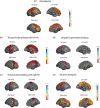The ENIGMA-Epilepsy working group: Mapping disease from large data sets
- PMID: 32468614
- PMCID: PMC8675408
- DOI: 10.1002/hbm.25037
The ENIGMA-Epilepsy working group: Mapping disease from large data sets
Abstract
Epilepsy is a common and serious neurological disorder, with many different constituent conditions characterized by their electro clinical, imaging, and genetic features. MRI has been fundamental in advancing our understanding of brain processes in the epilepsies. Smaller-scale studies have identified many interesting imaging phenomena, with implications both for understanding pathophysiology and improving clinical care. Through the infrastructure and concepts now well-established by the ENIGMA Consortium, ENIGMA-Epilepsy was established to strengthen epilepsy neuroscience by greatly increasing sample sizes, leveraging ideas and methods established in other ENIGMA projects, and generating a body of collaborating scientists and clinicians to drive forward robust research. Here we review published, current, and future projects, that include structural MRI, diffusion tensor imaging (DTI), and resting state functional MRI (rsfMRI), and that employ advanced methods including structural covariance, and event-based modeling analysis. We explore age of onset- and duration-related features, as well as phenomena-specific work focusing on particular epilepsy syndromes or phenotypes, multimodal analyses focused on understanding the biology of disease progression, and deep learning approaches. We encourage groups who may be interested in participating to make contact to further grow and develop ENIGMA-Epilepsy.
Keywords: DTI; MRI; covariance; deep learning; event-based modeling; gene expression; genetics; imaging; quantitative; rsfMRI.
© 2020 The Authors. Human Brain Mapping published by Wiley Periodicals, Inc.
Figures




References
-
- Alexander‐Bloch, A. , Raznahan, A. , Bullmore, E. , & Giedd, J. (2013). The convergence of maturational change and structural covariance in human cortical networks. The Journal of Neuroscience: The Official Journal of the Society for Neuroscience, 33(7), 2889–2899. 10.1523/JNEUROSCI.3554-12.2013 - DOI - PMC - PubMed
-
- Allen, L. A. , Harper, R. M. , Kumar, R. , Guye, M. , Ogren, J. A. , Lhatoo, S. D. , … Diehl, B. (2017). Dysfunctional brain networking among autonomic regulatory structures in temporal lobe epilepsy patients at high risk of sudden unexpected death in epilepsy. Frontiers in Neurology, 8, 544. 10.3389/fneur.2017.00544 - DOI - PMC - PubMed
Publication types
Grants and funding
- 602102/European Union
- F1315030/University of Tübingen
- 403726/2016-6/FAPESP-BRAINN
- 61772440/National Nature Science Foundation of China
- HRBI_/Health Research Board/Ireland
- MR/L016311/1/MRC_/Medical Research Council/United Kingdom
- 1081151/National Health and Medical Research Council
- 1091593/National Health and Medical Research Council
- 181508; 232676; 251216; 280283/Mexican Council of Science and Technology
- MR/K013998/1/MRC_/Medical Research Council/United Kingdom
- Monash University
- S10 OD023696/OD/NIH HHS/United States
- MR/N008324/1/MRC_/Medical Research Council/United Kingdom
- 2013/07599-3/FAPESP-BRAINN
- R01 AG059874/AG/NIA NIH HHS/United States
- 180365/Schweizerischer Nationalfonds zur Forderung der Wissenschaftlichen Forschung (SNF)
- 2013/07559-3/FAPESP-BRAINN
- R21 NS107739/NS/NINDS NIH HHS/United States
- R01NS110347/NIH/NINDS
- DH_/Department of Health/United Kingdom
- R01 MH118514/MH/NIMH NIH HHS/United States
- NET-2013-02355313/Ministry of Health
- MR/S00355X/1/MRC_/Medical Research Council/United Kingdom
- 1R21NS107739-01A1/NS/NINDS NIH HHS/United States
- R01 NS065838; R21 NS107739/University of Tübingen
- R01 EB015611/EB/NIBIB NIH HHS/United States
- 07559-3/FAPESP-BRAINN
- NIH
- MOP-57840/CIHR
- R01 NS122827/NS/NINDS NIH HHS/United States
- R01 NS065838/NS/NINDS NIH HHS/United States
- R01 MH116147/MH/NIMH NIH HHS/United States
- IB201712/UNAM-DGAPA
- L016311/1/MRC_/Medical Research Council/United Kingdom
- FDN-154298/CIHR
- U54 EB020403/EB/NIBIB NIH HHS/United States
- MR/K023152/1/MRC_/Medical Research Council/United Kingdom
- National Institute for Health Research (NIHR)
- R56 AG058854/AG/NIA NIH HHS/United States
- NI17-039/SickKids Foundation
- R01 AG059874; R01 MH117601/National Health and Medical Research Council
- 180365/SNSF_/Swiss National Science Foundation/Switzerland
- MR/S00355X/1; MR/K023152/1/MRC_/Medical Research Council/United Kingdom
- MR/N008324/1/Tenure-track Clinician Scientist Fellowship
- MRFF1136427/University of Melbourne
- FAPESP
- European Regional Development Fund
- 1085/Epilepsy Research UK
- Discovery-1304413/NSERC
- 2013/07559-3/São Paulo Research Foundation
- FRQS
- 16/RC/3948; 08/RFP/GEN1538/SFI_/Science Foundation Ireland/Ireland
- 163398/Schweizerischer Nationalfonds zur Forderung der Wissenschaftlichen Forschung (SNF)
- R01 NS110347/NS/NINDS NIH HHS/United States
- South African Medical Research Council
- MOP-123520; MOP-130516/CIHR
- S10OD023696; R01EB015611/National Health and Medical Research Council
- FO750/5-1/Deutsche Forschungsgemeinschaft (DFG)
LinkOut - more resources
Full Text Sources
Miscellaneous

